Minister of Defence General Ngô Xuân Lịch | Founded 22 December 1944 | |
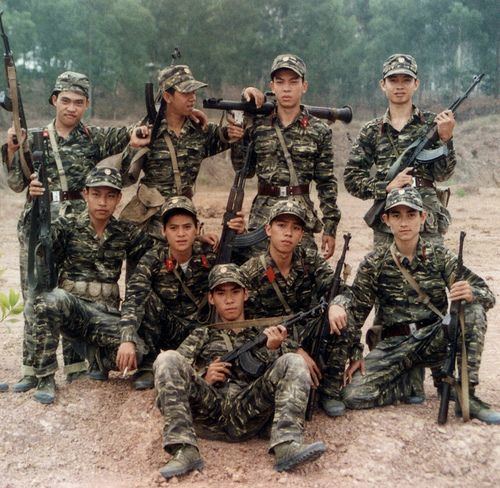 | ||
Commander-in-Chief (de jure)Commander (de facto) President Trần Đại QuangGeneral Secretary Nguyễn Phú Trọng Chief of Staff Lieutenant General Phan Văn Giang Military age 18–25 years old (18–27 for those who attend colleges or universities) Conscription 24 months for all able-bodied men | ||
The People's Army of Vietnam (PAVN; Vietnamese: Quân Đội Nhân Dân Việt Nam), also known as the Vietnamese People's Army, is the military force of the Socialist Republic of Vietnam. The PAVN is a part of Vietnam People's Armed Forces and includes: Ground Force (including Strategic Rear Forces), Navy, Air Force, Border Defence Force, and Coast Guard. However, Vietnam does not have a specific separate Ground Force or Army branch. All ground troops, army corps, military districts and specialised arms belong to the Ministry of Defence, directly under command of the Central Military Commission, Minister of Defence, and General Staff of the Vietnam People's Army. The military flag of the PAVN is the flag of the Socialist Republic of Vietnam, with the words Quyết thắng (Determination to win) added in yellow at the top left.
Contents
- Establishment
- French Indochina War
- Vietnam War
- Military activities 19751990
- Peacetime
- International presence
- Organisation
- Service branches
- Vietnam Peoples Ground Forces
- Military regions
- Main force
- Local forces
- Vietnam Coast Guard
- Ranks and insignia
- Equipment
- References

During the French Indochina War (1946–1954), the PAVN was often referred to as the Việt Minh. In the context of the Vietnam War (1959–1975), the army was referred to as the North Vietnamese Army (NVA). This allowed writers, the US military, and the general public, to distinguish northern communists from the southern communists, or Viet Cong. However, both groups ultimately worked under the same command structure. According to Hanoi's official history, the Viet Cong was a branch of the VPA. In 2010 the PAVN undertook the role of leading the 1,000th Anniversary Parade in Hanoi by performing their biggest parade in history.
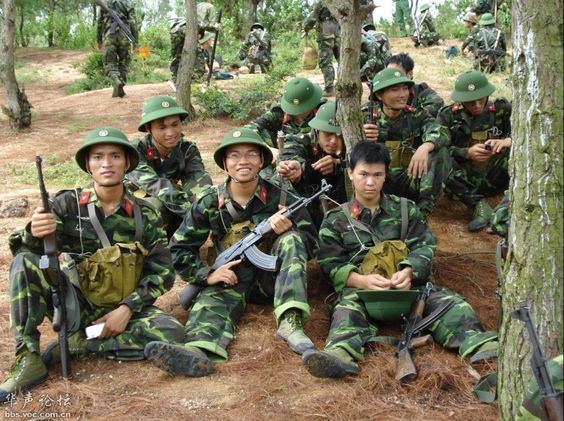
Establishment
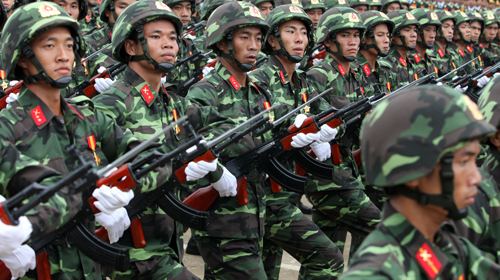
The PAVN was first conceived in September 1944 at the first Revolutionary Party Military Conference as "armed propaganda brigades" to educate, recruit and mobilise the Vietnamese to create a main force to drive the French colonial and Japanese occupiers from Vietnam. Under the guidelines of Hồ Chí Minh, Võ Nguyên Giáp was given the task of establishing the brigades and the Armed Propaganda Unit for National Liberation came into existence on 22 December 1944. The first formation was made up of thirty one men and three women, armed with two revolvers, seventeen rifles, one light machine gun, and fourteen breech-loading flintlocks.
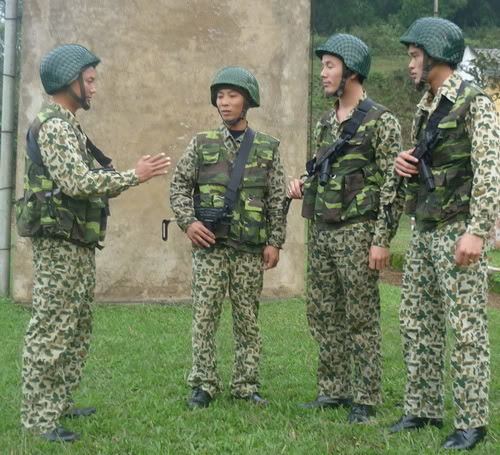
The group was renamed the "Vietnam Liberation Army" in May 1945. In September, the army was again renamed the "Vietnam National Defence Army." At this point, it had about 1,000 soldiers. In 1950, it officially became the People's Army of Vietnam.
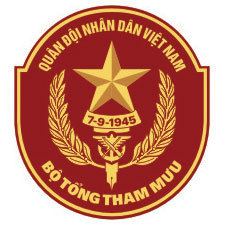
Võ Nguyên Giáp went on to become the first full General of the VPA on 28 May 1948, and famous for leading the PAVN in victory over French forces at the Battle of Dien Bien Phu in 1954 and being in overall command against US backed South Vietnam at the Fall of Saigon on 30 April 1975.
French Indochina War
On 7 January 1947, its first regiment, the 102nd 'Capital' Regiment, was created for operations around Hanoi. Over the next two years, the first division, the 308th Division, later well known as the Pioneer Division formed by the 88th Tu Vu Regiment and the 102nd Capital Regiment. By late 1950 the 308th Division had a full three infantry regiments, when it was supplemented by the 36th Regiment. At that time, the 308th Division was also backed by the 11th Battalion that later became the main force of the 312th Division. In late 1951, after launching three campaigns against three French strongpoints in the Red River Delta, the PAVN refocused on building up its ground forces further, with five new divisions, each of 10–15,000 men, created: the 304th Glory Division at Thanh Hóa, the 312th Victory Division in Vinh Phuc, the 316th Bong Lau Division in the northwest border region, the 320th Delta Division in the north Red River Delta, the 325th Binh Tri Thien Division in Binh Tri Thien province. Also in 1951, the first artillery Division, the 351st Division was formed, and later, before Battle of Dien Bien Phu in 1954, for the first time in history, it was equipped by 24 captured 105mm US howitzers supplied by the Chinese People's Liberation Army. The first six divisions (308th, 304th, 312nd, 316th, 320th, 325th) became known as the original PAVN 'Steel and Iron' divisions. In 1954 four of these divisions (the 308th, 304th, 312nd, 316th, supported by the 351st Division's captured US howitzers) defeated the French Union forces at the Battle of Dien Bien Phu, ending 83 years of French rule in Indochina.
Vietnam War
Soon after the 1954 Geneva Accords, the 330th and 338th Divisions were formed by southern Vietminh members who had moved north in conformity with that agreement, and by 1955, six more divisions were formed: the 328th, 332nd, and 350th in the north of the DRV, the 305th and the 324th near the DMZ, and the 335 Division of soldiers repatriated from Laos. In 1957, the theatres of the war with the French were reorganised as the first five military regions, and in the next two years, several divisions were reduced to brigade size to meet the manpower requirements of collective farms.
By 1958 it was becoming increasingly clear that the South Vietnamese government was solidifying its position as an independent republic under Ngô Đình Diệm who staunchly opposed the terms of the Geneva Accord that required a national referendum on unification of north and south Vietnam under a single national government, and North Vietnam prepared to settle the issue of unification by force.
In May 1959 the first major steps to prepare infiltration routes into South Vietnam were taken; Group 559 was established, a logistical unit charged with establishing routes into the south via Laos and Cambodia, which later became famous as the Ho Chi Minh trail. At about the same time, Group 579 was created as its maritime counterpart to transport supplies into the South by sea. Most of the early infiltrators were members of the 338th Division, former southerners who had been settled at Xuan Mai from 1954 onwards.
Regular formations were sent to Southern Vietnam from 1965 onwards; the 325th Division's 101B Regiment and the 66th Regiment of the 304th Division met US forces on a large scale, a first for the PAVN, at the Battle of Ia Drang Valley in November 1965. The 308th Division's 88A Regiment, the 312th Division's 141A, 141B, 165A, 209A, the 316th Division's 174A, the 325th Division's 95A, 95B, the 320A Division also faced the US forces which included the 1st Cavalry Division, the 101st Airborne Division, the 173d Airborne Brigade, the 4th Infantry Division, the 1st Infantry Division, and the 25th Infantry Division. Those PAVN formations were seen as extremely brave forces by the US forces. Many of those formations later became main forces of the 3rd Division (Yellow Star Division) in Binh Dinh (1965), the 5th Division (1966) of 7th Military Zone (Capital Tactical Area of ARVN), the 7th (created by 141st and 209th Regiments originated in the 312th Division in 1966) and 9th Divisions (first Division of National Liberation Front of Vietnam in 1965 in Mekong Delta), the 10th Dakto Division in Dakto – Highland in 1972 south of Vietnam.
General Trần Văn Trà one-time commander of the B2 Front (Saigon) HQ confirms that even though the PAVN and the NLFV were confident in their ability to defeat the regular ARVN forces, US intervention in Vietnam forced them to reconsider their operations. The decision was made to continue to pursue "main force" engagements even though "there were others in the South – they were not military people – who wanted to go back to guerrilla war," but the strategic aims were adjusted to meet the new reality.
We had to change our plan and make it different from when we fought the Saigon regime, because we now had to fight two adversaries — the United States and South Vietnam. We understood that the U.S. Army was superior to our own logistically, in weapons and in all things. So strategically we did not hope to defeat the U.S. Army completely. Our intentions were to fight a long time and cause heavy casualties to the United States, so the United States would see that the war was unwinnable and would leave.
During the Vietnamese Lunar New Year Tết holiday starting on 30 January 1968, the PAVN launched a general offensive in more than 60 cities and towns throughout south of Vietnam against the US Army and Army of the Republic of Vietnam-(ARVN), beginning with operations in the border region to try and draw US forces and ARVN troops out of the major cities. In sequential coordinated attacks, the U.S Embassy in Saigon, Presidential Palace, Headquarters of ARVN and ARVN's Navy, TV and Radio Stations, Tan Son Nhat International Airport in Saigon were attacked and invaded by commando forces known as "Dac Cong".
This offensive became known as the "Tet Offensive."
The offensives caught the world's attention day-by-day and demoralised the US public and military, both at home and abroad. The PAVN sustained heavy losses of its main forces in southern military zones. Some of its regular forces and command structure had to escape to Laos and Cambodia to avoid counterattacks from US forces and ARVN, while local guerrillas forces and political organisations in South Vietnam were exposed and had a hard time remaining within the Mekong Delta area due to the extensive use of the Phoenix Program and were never restored.
Although the PAVN lost militarily to the US forces and ARVN in the south, the political impact of the war in the United States was strong. Public demonstrations increased in ferocity and quantity after the Tet Offensive. Onwards from 1970, the 5th, 7th, and 9th divisions had fought in Cambodia against US forces, ARVN, and Cambodian Prime Minister Lon Nol's troops but they had gained new allies: the Khmer Rouge and guerrilla fighters supporting deposed Prime Minister Sihanouk. In 1975 the PAVN were successful in aiding the Khmer Rouge in toppling the Lon Nol's US-backed regime, despite heavy US bombing.
After the withdrawal of most United States' combat forces from Indochina because of the Vietnamization strategy, the PAVN launched the ill-fated Easter Offensive in 1972. Although successful at the beginning, the South Vietnamese repulsed the main assaults with U.S. air support. Still North Vietnam gained significant territories.
Nearly two years after the full United States' withdrawal from Indochina in accord with the terms of the 1973 Paris Peace Accords, the PAVN launched a Spring Offensive aimed at uniting Vietnam. Without direct support of its US ally, and suffering from stresses caused by dwindling aid, the ARVN was ill prepared to confront the highly motivated PAVN, and despite numerical superiority of the ARVN in tactical aircraft, armoured vehicles and overwhelming three to one odds in regular troops, the PAVN quickly secured victory within two months and captured Saigon on 30 April 1975, effectively ending the 70 years of conflict stemming from French colonial invasion of the 19th century and unifying Vietnam.
Military activities (1975–1990)
Towards the second half of the 20th century the armed forces of Vietnam would participate in organised incursions to protect its citizens and allies against aggressive military factions in the neighbouring Indochinese countries of Laos and Cambodia, and the defensive border wars with China.
Both in Cambodia and in Laos, the heavily armed and battle-hardened People's Army of Vietnam were a valuable ally to the Pathet Lao and the Khmer Rouge forces, providing economic and military aid, also with new weapons, technologies and intelligence. Some claimed that just like the US Army's relationship with the ARVN, Kingdom of Laos and the Khmer Republic, the PAVN was the real power standing behind them and played key roles in bringing both the Khmer Rouge and Pathet Lao to power.
Peacetime
During peaceful periods, the PAVN has actively been involved in Vietnam's workforce to develop the economy of Vietnam, to co-ordinate national defence and the economy. The PAVN has regularly sent troops to aid with natural disasters such as flooding, landslides etc. The PAVN is also involved in such areas as industry, agriculture, forestry, fishery and telecommunications. The PAVN has numerous small firms which have become quite profitable in recent years. However, recent decrees have effectively prohibited the commercialisation of the military. Conscription is in place for every male, age 18 to 25 years old, though females can volunteer to join.
International presence
The Foreign Relations Department of the Ministry of National Defence organises international operations of the PAVN.
Apart from its occupation of half of the disputed Spratly Islands, which have been claimed as Vietnamese territory since the 17th century, Vietnam has not officially had forces stationed internationally since its withdrawal from Cambodia and Laos in early 1990.
The Center for Public Policy Analysis and non-governmental organisations (NGOs) as well as Laotian and Hmong human rights organisations, including the Lao Human Rights Council, Inc. and the United League for Democracy in Laos, Inc., have provided evidence that since the end of the Vietnam War, significant numbers of Vietnamese military and security forces continue to be sent to Laos, on a repeated basis, to quell and suppress Laotian political and religious dissident and opposition groups including the peaceful 1999 Lao Students for Democracy protest in Vientiane in 1999 and the Hmong rebellion. Rudolph Rummel has estimated that 100,000 Hmong perished in genocide between 1975 and 1980 in collaboration with PAVN. For example, in late November 2009, shortly before the start of the 2009 Southeast Asian Games in Vientiane, the PAVN undertook a major troop surge in key rural and mountainous provinces in Laos where Lao and Hmong civilians and religious believers, including Christians, have sought sanctuary.
Organisation
The Commander-in-Chief of the Armed Forces is the President of Vietnam, though this position is nominal and real power is assumed by the Central Military Commission of the ruling Communist Party of Vietnam. The secretary of Central Military Commission (usually the General Secretary of the Communist Party of Vietnam) is the de facto Commander and now is Nguyễn Phú Trọng.
The Minister of National Defence oversees operations of the Ministry of Defence, and the PAVN. He also oversees such agencies as the General Staff and the General Logistics Department. However, military policy is ultimately directed by the Central Military Commission of the ruling Communist Party of Vietnam.
Service branches
The Vietnamese People's Army is subdivided into the following service branches:
The People's Army of Vietnam is a "triple armed force" composed of the Main Force, the Local Force and the Border Force. As with most countries' armed forces, the PAVN consists of standing, or regular, forces as well as reserve forces. During peacetime, the standing forces are minimised in number, and kept combat-ready by regular physical and weapons training, and stock maintenance.
Vietnam People's Ground Forces
Within PAVN the Ground Forces have not been established as a full Command, thus all of the ground troops, army corps, military districts, specialised arms belong to the Ministry of Defence, under directly command of the General Staff . The Vietnam Strategic Rear Forces (Lực lượng dự bị chiến lược) is also a part of the Ground Forces.
Military regions
Main force
The Main Force of the PAVN consists of combat ready troops, as well as support units such as educational institutions for logistics, officer training, and technical training. In 1991, Conboy et al. stated that the PAVN Ground Force had four 'Strategic Army Corps' in the early 1990s, numbering 1–4, from north to south. 1st Corps, located in the Red River Delta region, consisted of the 308th (one of the six original 'Steel and Iron' divisions) and 312th Divisions, and the 309th Infantry Regiment. The other three corps, 2 SAC, 3 SAC, and 4 SAC, were further south, with 4th Corps, in Southern Vietnam, consisting of two former PLAF divisions, the 7th and 9th.
The IISS Military Balance 2016 attributes the Vietnamese ground forces with an estimated 412,000 personnel. Formations, according to the IISS, include 8 military regions, 4 corps headquarters, 1 special forces airborne brigade, 6 armoured brigades and 3 armoured regiments, two mechanised infantry divisions, and 23 active infantry divisions plus another 9 reserve ones.
Combat support formations include 13 artillery brigades and one artillery regiment, 11 air defence brigades, 10 engineers brigades, 1 electronic warfare unit, 3 signals brigades and 2 signals regiment.
Combat service support formations includee 9 economic construction divisions, 1 logistical regiment, 1 medical unit and 1 training regiment.
1st Corps - Binh đoàn Quyết thắng (Corps of Determined Victory):
First organised on 24 October 1973 during the Vietnam War, 1st Corps had a major role in the Ho Chi Minh Campaign that ended the war. Stationed in Tam Điệp District, Ninh Bình. The combat forces of the corps include:
2nd Corps - Binh đoàn Hương Giang (Corps of the Perfume River):
First organised on 17 May 1974 during the Vietnam War, 2nd Corps had a major role in the Ho Chi Minh Campaign that ended the war. Stationed in Lạng Giang District, Bắc Giang. The combat forces of the corps include:
3rd Corps - Binh đoàn Tây Nguyên (Corps of Central Highland):
First organised on 26 March 1975 during the Vietnam War, 3rd Corps had a major role in the Ho Chi Minh Campaign and the Cambodian–Vietnamese War. Stationed in Pleiku, Gia Lai. The combat forces of the corps include:
4th Corps - Binh đoàn Cửu Long (Corps of Mekong):
First organised 20 July 1974 during the Vietnam War, 4th Corps had a major role in the Ho Chi Minh Campaign and the Cambodian–Vietnamese War. Stationed in Dĩ An, Bình Dương. The combat forces of the corps include:
Local forces
Local forces are an entity of the PAVN that, together with the militia and "self-defence forces," act on the local level in protection of people and local authorities. While the local forces are regular VPA forces, the people's militia consists of rural civilians, and the people's self-defence forces consist of civilians who live in urban areas and/or work in large groups, such as at construction sites or farms. The current number stands at 3–4 million part-time soldiers.
Vietnam Coast Guard
As mentioned above, reserves exist in all branches and are organised in the same way as the standing forces, with the same chain of command, and with officers and non-commissioned officers.
Ranks and insignia
Equipment
From the 1960s to 1975, the Soviet Union was the main supplier of military hardware to North Vietnam. After the latter's victory in the war, it remained the main supplier of equipment to Vietnam. The United States had been the primary supplier of equipment to South Vietnam; much of the equipment abandoned by the US Army and Army of the Republic of Vietnam (ARVN) came under control of the re-unified Vietnamese government. The PAVN captured large numbers of ARVN weapons on 30 April 1975 after Saigon was captured.
